Overview
Databricks is a powerful unified platform that seamlessly integrates data, analytics, and AI to empower organizations in content creation, research, and analysis. By leveraging advanced AI capabilities like NLP, computer vision, and generative AI, it enables users to transform raw data into actionable insights and creative outputs. Whether you’re a data scientist, analyst, or content creator, Databricks simplifies complex workflows with its serverless data warehouse, real-time analytics, and Delta Lake for reliable data management, making it easier to build and deploy AI-driven solutions.
Designed for teams looking to harness the full potential of their data, Databricks stands out with its open marketplace, offering access to a wealth of data and AI resources. Its unified approach eliminates silos, allowing users to streamline ETL processes, enhance data governance, and accelerate AI development. From generating dynamic content to uncovering deep research insights, Databricks provides the tools to innovate faster and smarter, all while ensuring performance and scalability. It’s not just a platform—it’s a catalyst for turning data into intelligence.
Key Features
- Unified platform for data, analytics and AI
- Serverless data warehouse for SQL analytics
- Open marketplace for data, analytics and AI
- Real-time analytics, AI and applications
- Delta Lake for data reliability and performance
- Unity Catalog for unified governance
- Build and deploy ML and GenAI applications
- ETL and orchestration for batch/streaming data
- Zero-copy data sharing with Delta Sharing
- Collaborative data science at scale
Use Cases
Automated Content Generation
Databricks leverages AI to streamline content creation by generating high-quality, contextually relevant text for blogs, reports, and marketing materials. The tool analyzes input data, identifies key themes, and produces coherent, engaging content tailored to specific audiences. This reduces manual effort while maintaining consistency and creativity across all outputs.
Data-Driven Research Assistance
Databricks accelerates research by processing vast datasets to extract actionable insights. The AI tool identifies patterns, summarizes findings, and provides evidence-based recommendations. Researchers can quickly validate hypotheses, uncover trends, and compile comprehensive reports, saving time and improving accuracy in fields like academia, market analysis, and competitive intelligence.
Advanced Analytics and Visualization
Databricks transforms raw data into intuitive visualizations and interactive dashboards. The AI-powered analytics engine processes complex datasets to highlight correlations, outliers, and predictive trends. Users gain deeper understanding through dynamic charts, graphs, and heatmaps, enabling data-driven decision-making for business strategies, operational improvements, and performance tracking.
Target Audience & Industries
Target Audience
Databricks serves businesses, individuals, and students by providing a unified data analytics platform. Businesses benefit from scalable data processing, AI-driven insights, and collaborative tools to streamline decision-making. Individuals gain access to powerful data tools for personal projects or freelance work, while students can leverage the platform for learning data science, machine learning, and big data technologies in an industry-standard environment.
Target Industries
Industries that benefit most from Databricks include technology, finance, healthcare, retail, and manufacturing. Tech companies use it for AI and machine learning development, financial services for fraud detection and risk analysis, healthcare for patient data analytics, retail for customer behavior insights, and manufacturing for predictive maintenance and supply chain optimization. Its versatility makes it ideal for any data-intensive sector.
Evaluation and Review
Advantages
- Unified Platform: Combines data, analytics, and AI in a single environment, streamlining workflows and reducing complexity.
- Scalable Collaboration: Enables teams to collaborate on data science projects at scale with shared resources and governance.
- High-Performance Data Processing: Leverages Delta Lake for reliable, fast data operations, improving efficiency in ETL and analytics.
- Flexible AI Deployment: Supports building and deploying ML and GenAI applications, accelerating innovation in content creation and research.
- Real-Time Insights: Provides real-time analytics capabilities, allowing businesses to act on live data for faster decision-making.
- Open Data Ecosystem: Offers an open marketplace for data, analytics, and AI assets, fostering innovation and reducing vendor lock-in.
Limitations
- Learning curve: The unified platform offers extensive capabilities, which may require time and training for users to fully leverage, especially those new to data and AI workflows.
- Cost considerations: While powerful, the platform’s advanced features and serverless options may lead to higher costs for large-scale deployments or intensive workloads.
- Vendor lock-in potential: Heavy reliance on Databricks’ proprietary tools (e.g., Delta Lake, Unity Catalog) could make migrating to other platforms more challenging.
- Complexity for small-scale use cases: The breadth of features may be overkill for simpler projects or organizations with limited data or AI needs.
Other Information
Domain Info
Created at: 2011-07-13
Expires at: 2025-07-13
Interest over time
Worldwide. Past 90 days. Web Search.

